stop start KIA Sorento 2006 1.G User Guide
[x] Cancel search | Manufacturer: KIA, Model Year: 2006, Model line: Sorento, Model: KIA Sorento 2006 1.GPages: 312, PDF Size: 5.21 MB
Page 135 of 312
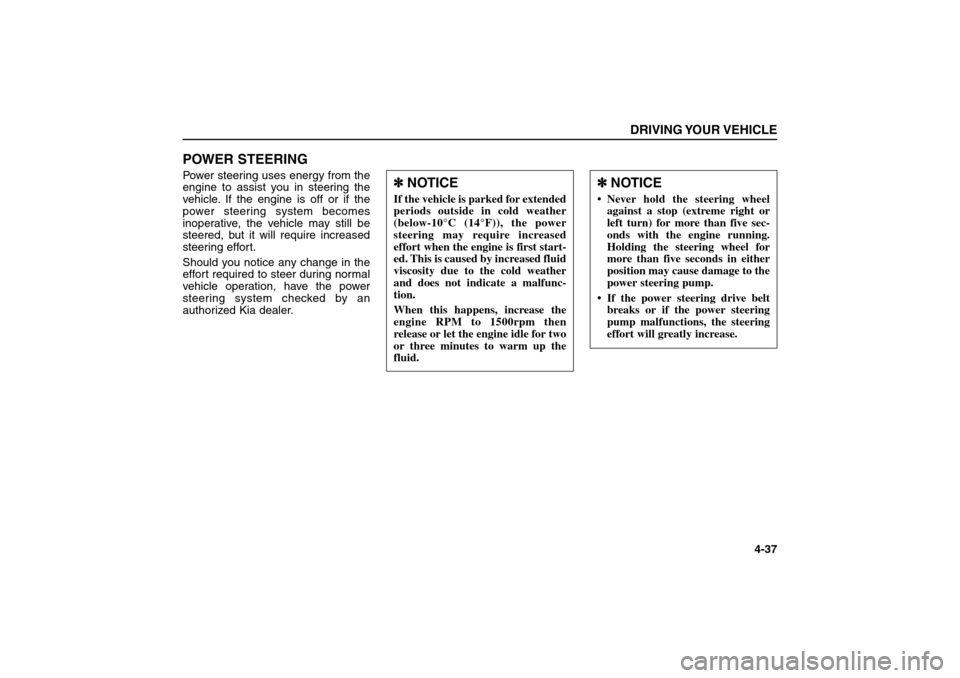
POWER STEERINGPower steering uses energy from the
engine to assist you in steering the
vehicle. If the engine is off or if the
power steering system becomes
inoperative, the vehicle may still be
steered, but it will require increased
steering effort.
Should you notice any change in the
effort required to steer during normal
vehicle operation, have the power
steering system checked by an
authorized Kia dealer.
DRIVING YOUR VEHICLE
4-37
✽ ✽
NOTICEIf the vehicle is parked for extended
periods outside in cold weather
(below-10°C (14°F)), the power
steering may require increased
effort when the engine is first start-
ed. This is caused by increased fluid
viscosity due to the cold weather
and does not indicate a malfunc-
tion.
When this happens, increase the
engine RPM to 1500rpm then
release or let the engine idle for two
or three minutes to warm up the
fluid.
✽ ✽
NOTICE Never hold the steering wheel
against a stop (extreme right or
left turn) for more than five sec-
onds with the engine running.
Holding the steering wheel for
more than five seconds in either
position may cause damage to the
power steering pump.
If the power steering drive belt
breaks or if the power steering
pump malfunctions, the steering
effort will greatly increase.
BL-ENG (CAN)-4.qxd 7/28/05 5:55 PM Page 37
Page 143 of 312
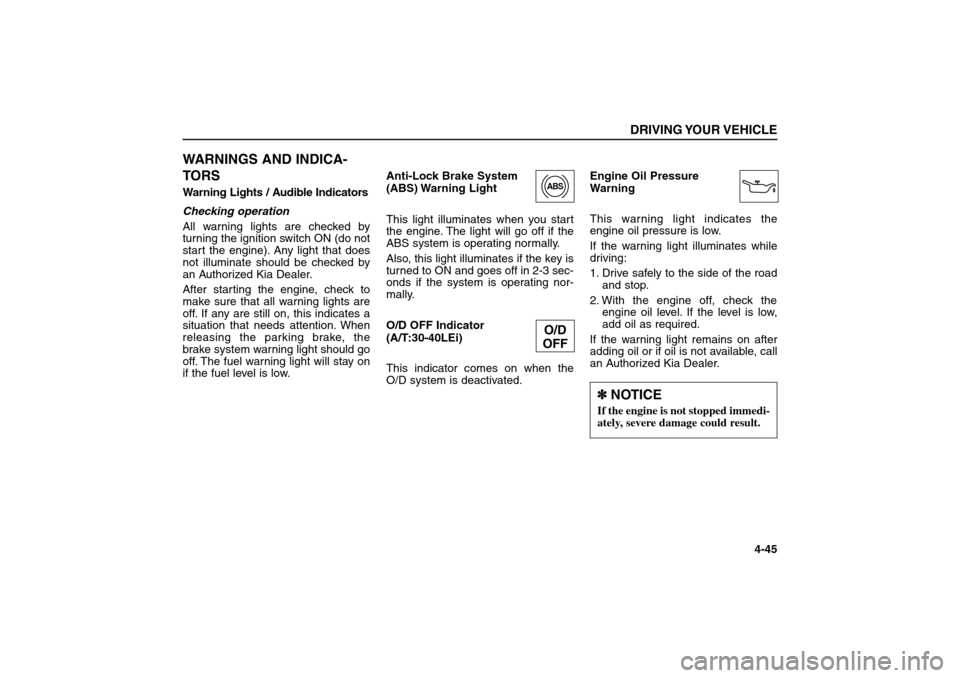
WARNINGS AND INDICA-
TORSWarning Lights / Audible Indicators
Checking operation
All warning lights are checked by
turning the ignition switch ON (do not
start the engine). Any light that does
not illuminate should be checked by
an Authorized Kia Dealer.
After starting the engine, check to
make sure that all warning lights are
off. If any are still on, this indicates a
situation that needs attention. When
releasing the parking brake, the
brake system warning light should go
off. The fuel warning light will stay on
if the fuel level is low.Anti-Lock Brake System
(ABS) Warning Light
This light illuminates when you start
the engine. The light will go off if the
ABS system is operating normally.
Also, this light illuminates if the key is
turned to ON and goes off in 2-3 sec-
onds if the system is operating nor-
mally.
O/D OFF Indicator
(A/T:30-40LEi)
This indicator comes on when the
O/D system is deactivated.Engine Oil Pressure
Warning
This warning light indicates the
engine oil pressure is low.
If the warning light illuminates while
driving:
1. Drive safely to the side of the road
and stop.
2. With the engine off, check the
engine oil level. If the level is low,
add oil as required.
If the warning light remains on after
adding oil or if oil is not available, call
an Authorized Kia Dealer.
DRIVING YOUR VEHICLE
4-45
ABSO/D
OFF
✽ ✽
NOTICEIf the engine is not stopped immedi-
ately, severe damage could result.
BL-ENG (CAN)-4.qxd 7/28/05 5:55 PM Page 45
Page 145 of 312
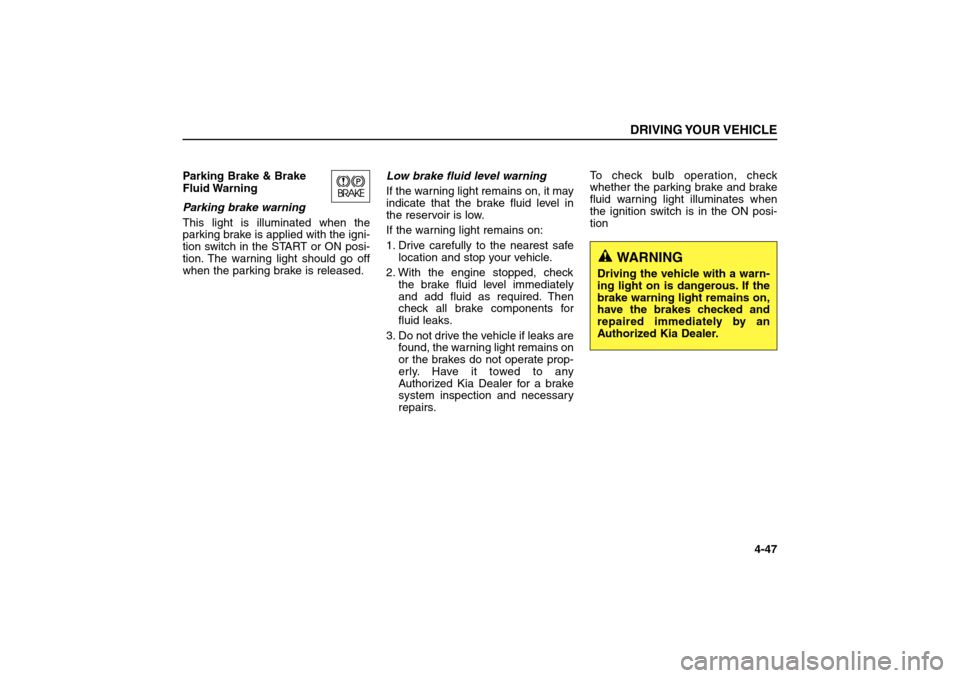
Parking Brake & Brake
Fluid Warning
Parking brake warning
This light is illuminated when the
parking brake is applied with the igni-
tion switch in the START or ON posi-
tion. The warning light should go off
when the parking brake is released.Low brake fluid level warning
If the warning light remains on, it may
indicate that the brake fluid level in
the reservoir is low.
If the warning light remains on:
1. Drive carefully to the nearest safe
location and stop your vehicle.
2. With the engine stopped, check
the brake fluid level immediately
and add fluid as required. Then
check all brake components for
fluid leaks.
3. Do not drive the vehicle if leaks are
found, the warning light remains on
or the brakes do not operate prop-
erly. Have it towed to any
Authorized Kia Dealer for a brake
system inspection and necessary
repairs.To check bulb operation, check
whether the parking brake and brake
fluid warning light illuminates when
the ignition switch is in the ON posi-
tion
DRIVING YOUR VEHICLE
4-47
WARNING
Driving the vehicle with a warn-
ing light on is dangerous. If the
brake warning light remains on,
have the brakes checked and
repaired immediately by an
Authorized Kia Dealer.
BL-ENG (CAN)-4.qxd 7/28/05 5:55 PM Page 47
Page 149 of 312
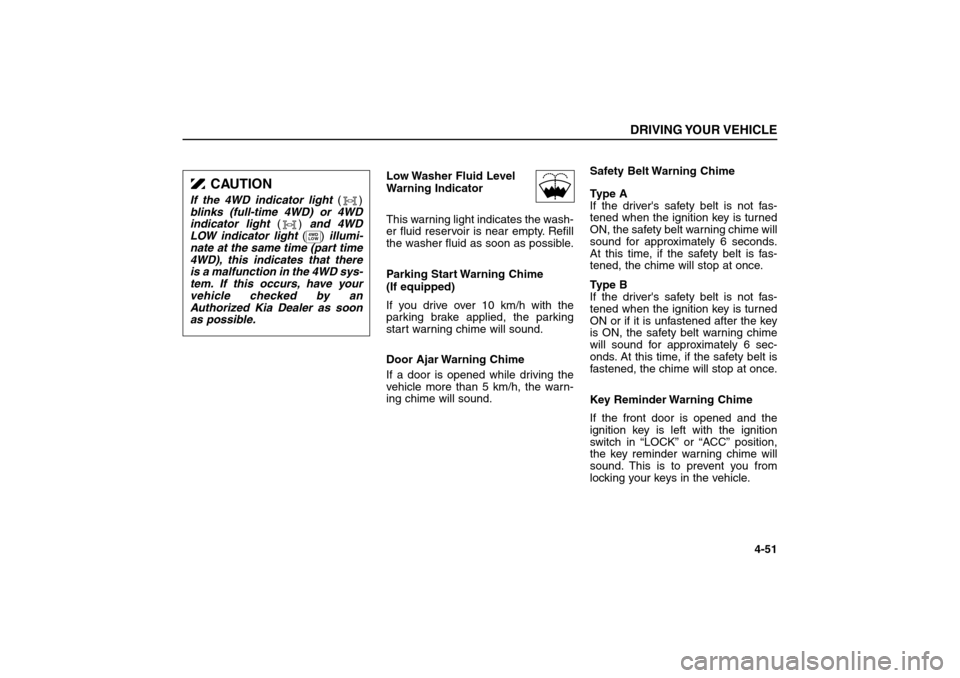
Low Washer Fluid Level
Warning Indicator
This warning light indicates the wash-
er fluid reservoir is near empty. Refill
the washer fluid as soon as possible.
Parking Start Warning Chime
(If equipped)
If you drive over 10 km/h with the
parking brake applied, the parking
start warning chime will sound.
Door Ajar Warning Chime
If a door is opened while driving the
vehicle more than 5 km/h, the warn-
ing chime will sound.Safety Belt Warning Chime
Type A
If the driver's safety belt is not fas-
tened when the ignition key is turned
ON, the safety belt warning chime will
sound for approximately 6 seconds.
At this time, if the safety belt is fas-
tened, the chime will stop at once.
Type B
If the driver's safety belt is not fas-
tened when the ignition key is turned
ON or if it is unfastened after the key
is ON, the safety belt warning chime
will sound for approximately 6 sec-
onds. At this time, if the safety belt is
fastened, the chime will stop at once.
Key Reminder Warning Chime
If the front door is opened and the
ignition key is left with the ignition
switch in “LOCK”or “ACC”position,
the key reminder warning chime will
sound. This is to prevent you from
locking your keys in the vehicle.
DRIVING YOUR VEHICLE
4-51
CAUTION
If the 4WD indicator light ()
blinks (full-time 4WD) or 4WD
indicator light () and 4WD
LOW indicator light ()illumi-
nate at the same time (part time
4WD), this indicates that there
is a malfunction in the 4WD sys-
tem. If this occurs, have your
vehicle checked by an
Authorized Kia Dealer as soon
as possible.
4WD
LOW
BL-ENG (CAN)-4.qxd 7/28/05 5:55 PM Page 51
Page 151 of 312
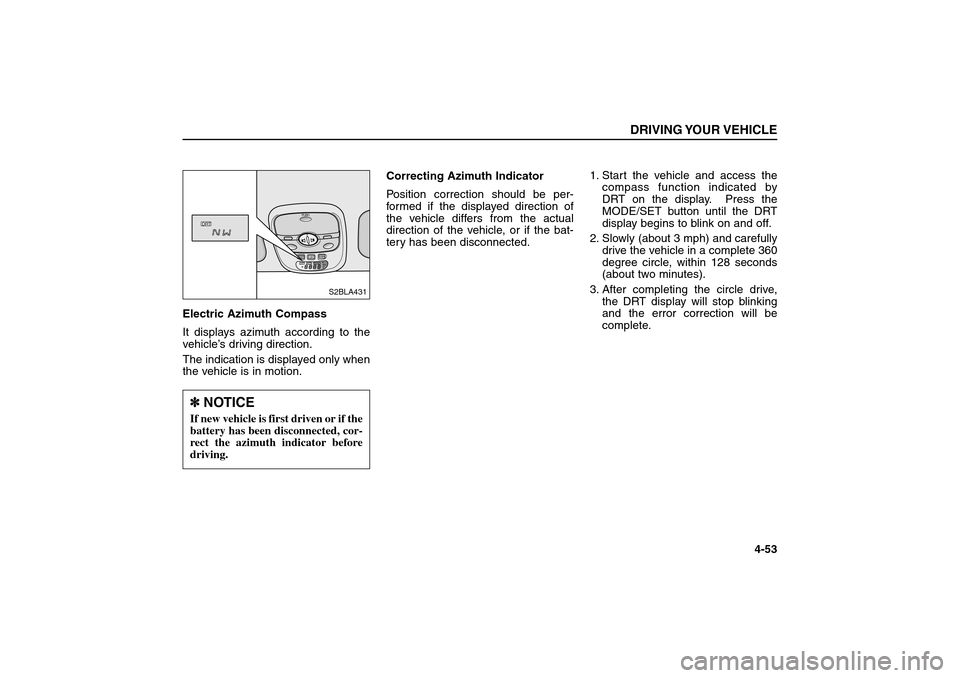
Electric Azimuth Compass
It displays azimuth according to the
vehicle’s driving direction.
The indication is displayed only when
the vehicle is in motion.Correcting Azimuth Indicator
Position correction should be per-
formed if the displayed direction of
the vehicle differs from the actual
direction of the vehicle, or if the bat-
tery has been disconnected.1. Start the vehicle and access the
compass function indicated by
DRT on the display. Press the
MODE/SET button until the DRT
display begins to blink on and off.
2. Slowly (about 3 mph) and carefully
drive the vehicle in a complete 360
degree circle, within 128 seconds
(about two minutes).
3. After completing the circle drive,
the DRT display will stop blinking
and the error correction will be
complete.
DRIVING YOUR VEHICLE
4-53
DRT ALTI BARO
E
hpa
m
ft
PUSHMODE
/SETUPDOWN
DRT
S2BLA431
✽ ✽
NOTICEIf new vehicle is first driven or if the
battery has been disconnected, cor-
rect the azimuth indicator before
driving.
BL-ENG (CAN)-4.qxd 7/28/05 5:55 PM Page 53
Page 159 of 312
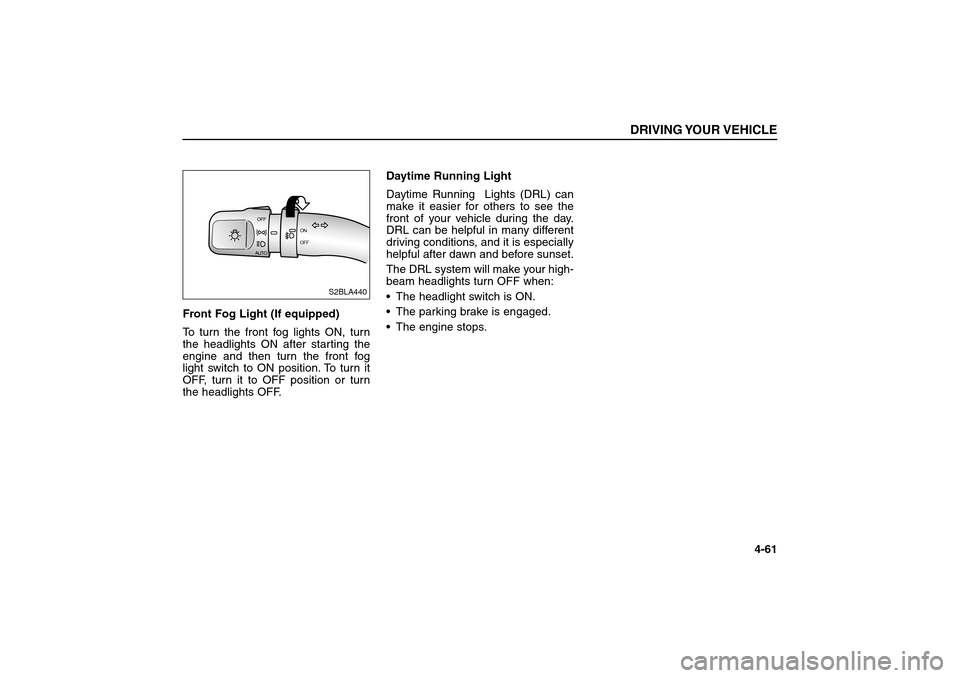
Front Fog Light (If equipped)
To turn the front fog lights ON, turn
the headlights ON after starting the
engine and then turn the front fog
light switch to ON position. To turn it
OFF, turn it to OFF position or turn
the headlights OFF.Daytime Running Light
Daytime Running Lights (DRL) can
make it easier for others to see the
front of your vehicle during the day.
DRL can be helpful in many different
driving conditions, and it is especially
helpful after dawn and before sunset.
The DRL system will make your high-
beam headlights turn OFF when:
The headlight switch is ON.
The parking brake is engaged.
The engine stops.
DRIVING YOUR VEHICLE
4-61
AUTOOFF
OFFON
S2BLA440
BL-ENG (CAN)-4.qxd 7/28/05 5:55 PM Page 61
Page 190 of 312
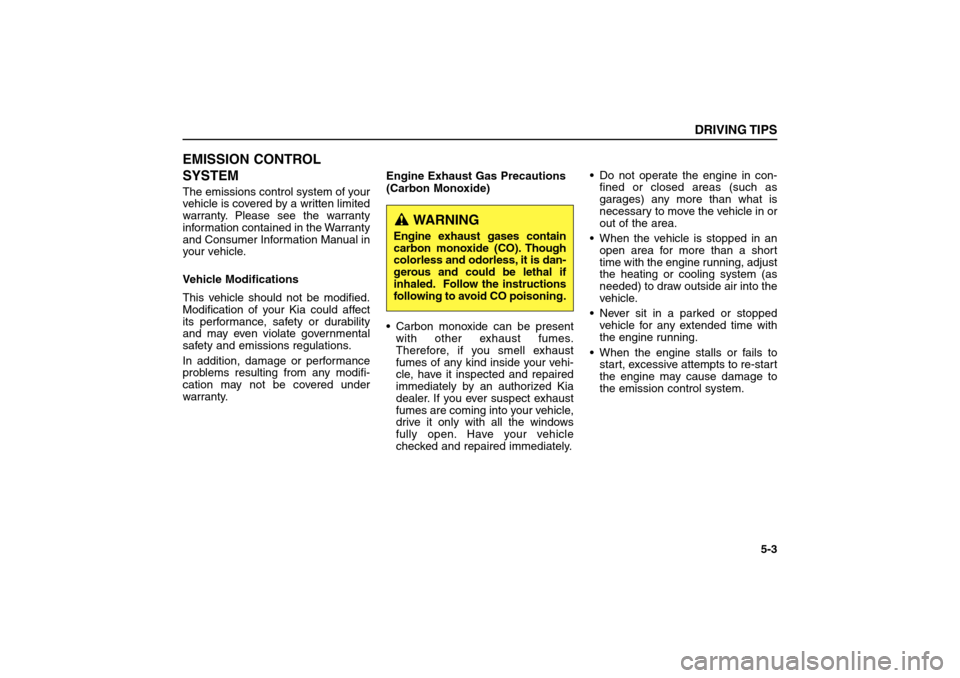
EMISSION CONTROL
SYSTEMThe emissions control system of your
vehicle is covered by a written limited
warranty. Please see the warranty
information contained in the Warranty
and Consumer Information Manual in
your vehicle.
Vehicle Modifications
This vehicle should not be modified.
Modification of your Kia could affect
its performance, safety or durability
and may even violate governmental
safety and emissions regulations.
In addition, damage or performance
problems resulting from any modifi-
cation may not be covered under
warranty.Engine Exhaust Gas Precautions
(Carbon Monoxide)
Carbon monoxide can be present
with other exhaust fumes.
Therefore, if you smell exhaust
fumes of any kind inside your vehi-
cle, have it inspected and repaired
immediately by an authorized Kia
dealer. If you ever suspect exhaust
fumes are coming into your vehicle,
drive it only with all the windows
fully open. Have your vehicle
checked and repaired immediately. Do not operate the engine in con-
fined or closed areas (such as
garages) any more than what is
necessary to move the vehicle in or
out of the area.
When the vehicle is stopped in an
open area for more than a short
time with the engine running, adjust
the heating or cooling system (as
needed) to draw outside air into the
vehicle.
Never sit in a parked or stopped
vehicle for any extended time with
the engine running.
When the engine stalls or fails to
start, excessive attempts to re-start
the engine may cause damage to
the emission control system.
DRIVING TIPS
5-3
WARNING
Engine exhaust gases contain
carbon monoxide (CO). Though
colorless and odorless, it is dan-
gerous and could be lethal if
inhaled. Follow the instructions
following to avoid CO poisoning.
BL-ENG (CAN)-5.qxd 7/28/05 5:56 PM Page 3
Page 197 of 312
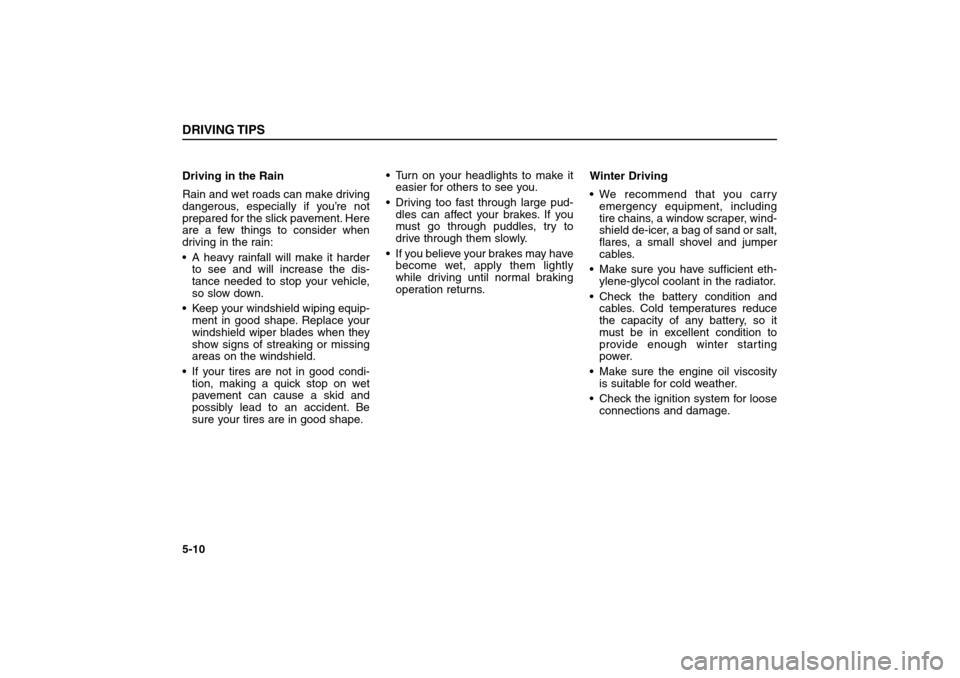
Driving in the Rain
Rain and wet roads can make driving
dangerous, especially if you’re not
prepared for the slick pavement. Here
are a few things to consider when
driving in the rain:
A heavy rainfall will make it harder
to see and will increase the dis-
tance needed to stop your vehicle,
so slow down.
Keep your windshield wiping equip-
ment in good shape. Replace your
windshield wiper blades when they
show signs of streaking or missing
areas on the windshield.
If your tires are not in good condi-
tion, making a quick stop on wet
pavement can cause a skid and
possibly lead to an accident. Be
sure your tires are in good shape. Turn on your headlights to make it
easier for others to see you.
Driving too fast through large pud-
dles can affect your brakes. If you
must go through puddles, try to
drive through them slowly.
If you believe your brakes may have
become wet, apply them lightly
while driving until normal braking
operation returns.Winter Driving
We recommend that you carry
emergency equipment, including
tire chains, a window scraper, wind-
shield de-icer, a bag of sand or salt,
flares, a small shovel and jumper
cables.
Make sure you have sufficient eth-
ylene-glycol coolant in the radiator.
Check the battery condition and
cables. Cold temperatures reduce
the capacity of any battery, so it
must be in excellent condition to
provide enough winter starting
power.
Make sure the engine oil viscosity
is suitable for cold weather.
Check the ignition system for loose
connections and damage.DRIVING TIPS5-10
BL-ENG (CAN)-5.qxd 7/28/05 5:56 PM Page 10
Page 206 of 312
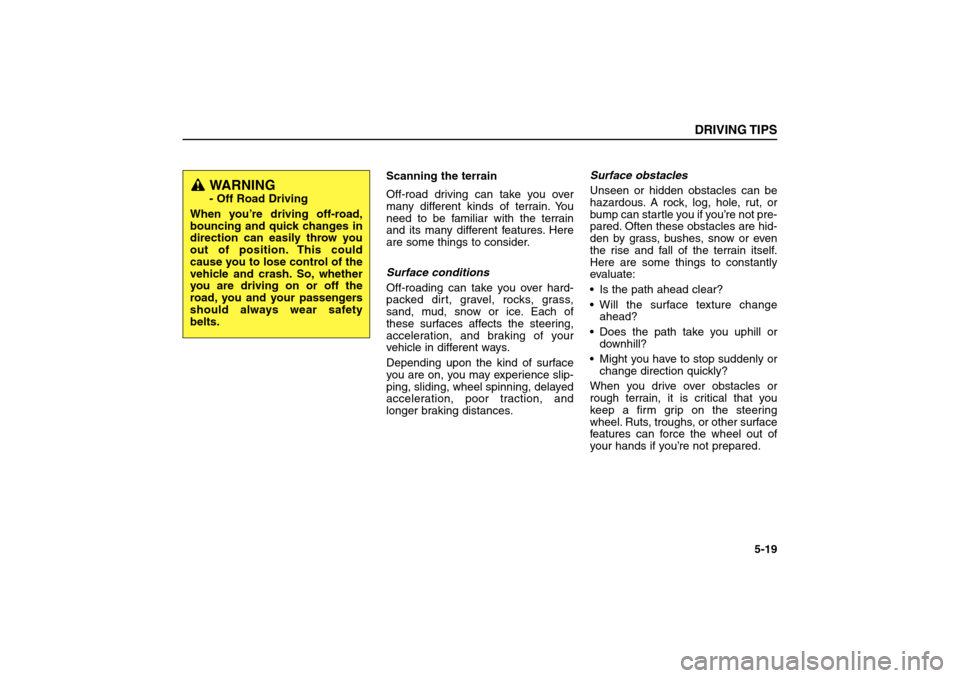
Scanning the terrain
Off-road driving can take you over
many different kinds of terrain. You
need to be familiar with the terrain
and its many different features. Here
are some things to consider.
Surface conditions
Off-roading can take you over hard-
packed dirt, gravel, rocks, grass,
sand, mud, snow or ice. Each of
these surfaces affects the steering,
acceleration, and braking of your
vehicle in different ways.
Depending upon the kind of surface
you are on, you may experience slip-
ping, sliding, wheel spinning, delayed
acceleration, poor traction, and
longer braking distances.Surface obstacles
Unseen or hidden obstacles can be
hazardous. A rock, log, hole, rut, or
bump can startle you if you’re not pre-
pared. Often these obstacles are hid-
den by grass, bushes, snow or even
the rise and fall of the terrain itself.
Here are some things to constantly
evaluate:
Is the path ahead clear?
Will the surface texture change
ahead?
Does the path take you uphill or
downhill?
Might you have to stop suddenly or
change direction quickly?
When you drive over obstacles or
rough terrain, it is critical that you
keep a firm grip on the steering
wheel. Ruts, troughs, or other surface
features can force the wheel out of
your hands if you’re not prepared.
DRIVING TIPS
5-19
WARNING- Off Road Driving
When you’re driving off-road,
bouncing and quick changes in
direction can easily throw you
out of position. This could
cause you to lose control of the
vehicle and crash. So, whether
you are driving on or off the
road, you and your passengers
should always wear safety
belts.
BL-ENG (CAN)-5.qxd 7/28/05 5:56 PM Page 19
Page 210 of 312
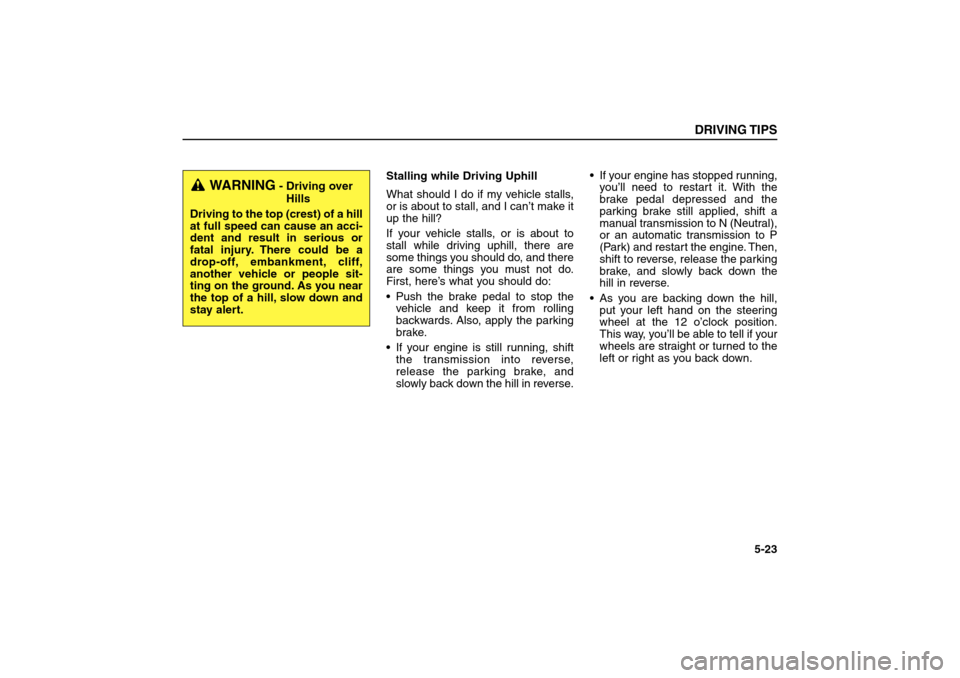
Stalling while Driving Uphill
What should I do if my vehicle stalls,
or is about to stall, and I can’t make it
up the hill?
If your vehicle stalls, or is about to
stall while driving uphill, there are
some things you should do, and there
are some things you must not do.
First, here’s what you should do:
Push the brake pedal to stop the
vehicle and keep it from rolling
backwards. Also, apply the parking
brake.
If your engine is still running, shift
the transmission into reverse,
release the parking brake, and
slowly back down the hill in reverse. If your engine has stopped running,
you’ll need to restart it. With the
brake pedal depressed and the
parking brake still applied, shift a
manual transmission to N (Neutral),
or an automatic transmission to P
(Park) and restart the engine. Then,
shift to reverse, release the parking
brake, and slowly back down the
hill in reverse.
As you are backing down the hill,
put your left hand on the steering
wheel at the 12 o’clock position.
This way, you’ll be able to tell if your
wheels are straight or turned to the
left or right as you back down.
DRIVING TIPS
5-23
WARNING
- Driving over
Hills
Driving to the top (crest) of a hill
at full speed can cause an acci-
dent and result in serious or
fatal injury. There could be a
drop-off, embankment, cliff,
another vehicle or people sit-
ting on the ground. As you near
the top of a hill, slow down and
stay alert.
BL-ENG (CAN)-5.qxd 7/28/05 5:56 PM Page 23